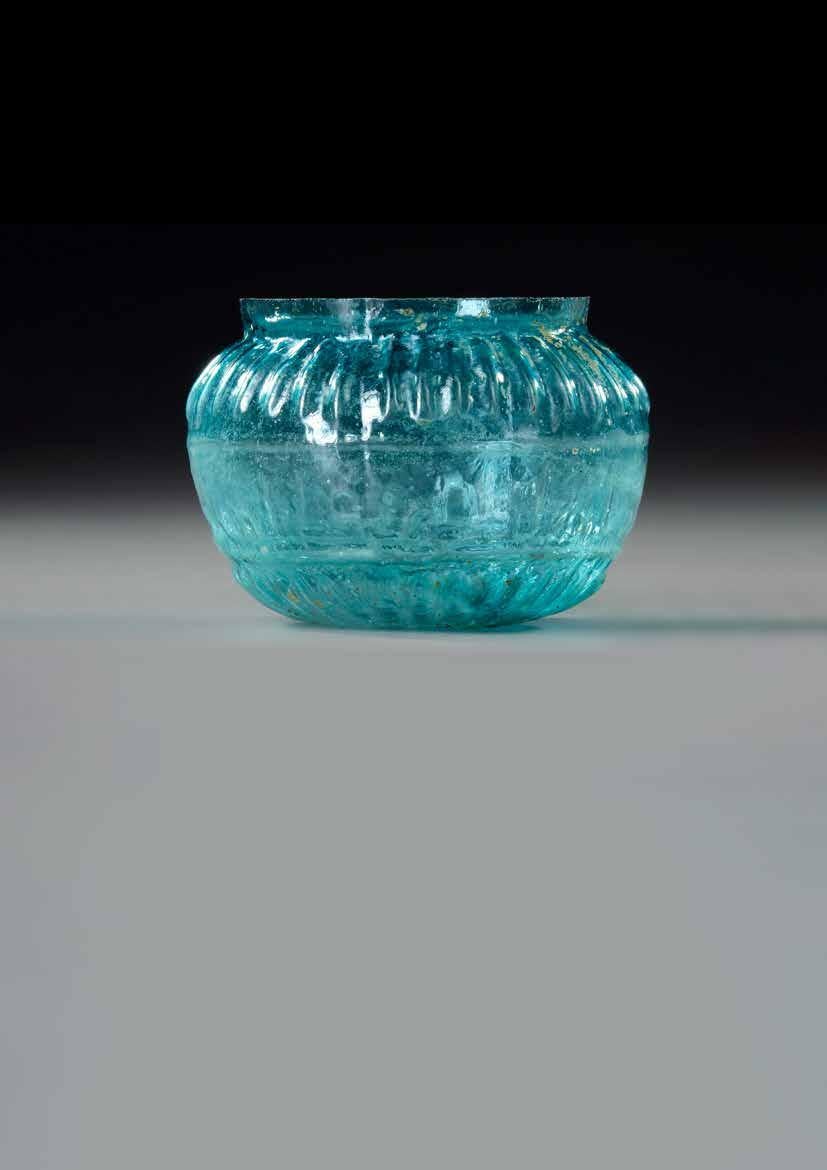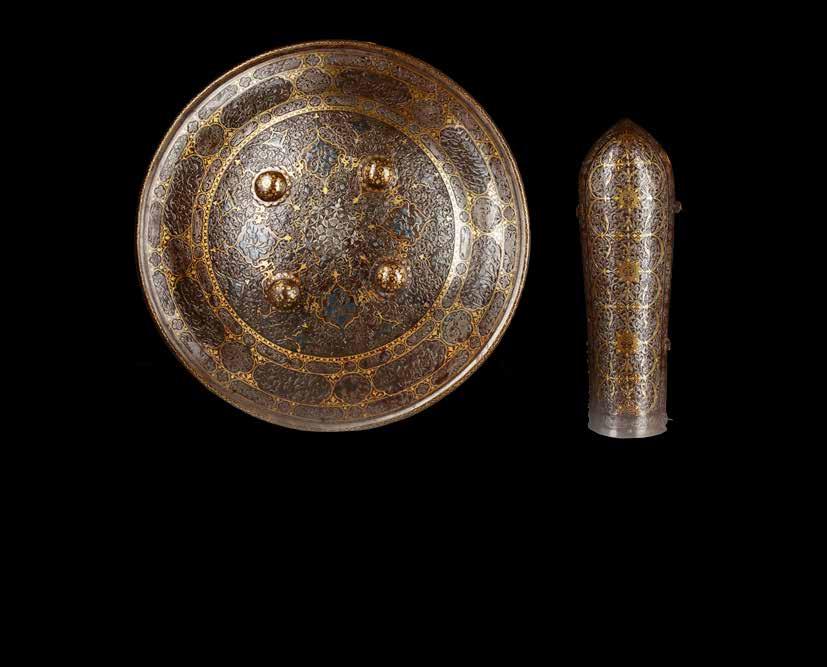
9 minute read
A GILT-COPPER OPENWORK FINIAL, MAMLUK EGYPT OR PROVINCES 15TH CENTURY
A standard, of circular form, decorated with three lines of elongated Thuluth script below a lamp emblem, remnants of gilding, heavy corrosion.
Diameter: 30 cm.
Advertisement
The partially legible inscriptions include the following:
Upper band: Allah … Muhammad
Central band: rasul Allah, Abu-Bakr…..
Lower band: ‘Umar al-faruq, ‘Uthman dhi’l nurayn.
This finial bears the names of the rightful Calips below the name of God and his Prophet Muhammad. Its form suggests it was a finial within a religious context. The script is clearly Mamluk in feel, as is the use of gilt-copper, even though the execution is relatively provincial. The tripartite division of the roundel also immediately suggests the Mamluk blazon concept, particularly from the later period, while the upper lamp also echoes the saqi or cup-bearer’s blazon. This echo Is enhanced by the upper band above the motif, similar to the upper part of a tripartite blazon.But the ‘blazon’ is a mosque lamp, not a cup, and the inscription is clearly completely religious, even if not all is easily decipherable. The form suggests a processional standard, but it has to be Sunni rather than Shiite, and in any case the support would need reinforcement were it to have been used on top of something that moved. It seems much more probable that it was made for use in a static context, potentially on top of an architectural element of possibly a furnishing such as a minbar.One further clue is given by the arrangement of the script. The larger bolder lettering runs the full height of each register, while through the centre runs a secondary series of words which are more angular and at times have elements, particularly the long horizontals that are more akin to kufic than to cursive scripts. This overlaying of a minor band of kufic through a band of larger cursive script was not a feature of Mamluk architecture, but is found throughout the Timurid world, possible indicating an origin near the borders with the Timurid realm.
Estimate € 8000 - € 12.000
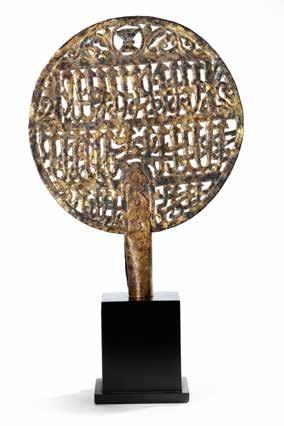
Lot 145
A IVORY HILTED WATERED-STEEL SWORD (SHAMSHIR), PERSIA
DATED 1244 AH/ 1828 AD
The hilt with cusped ivory grips with a curved, single-edged, tapering watered-steel blade, decorated with two gold-inlaid cartouches, a small cartouche enclosing “ his owner Ibrahim and dated 1244AH’, in its leather-covered wooden scabbard with russet iron mounts decorated with further gold cartouches.
Length: 96 cm.
PROVENANCE
Private collection, France
Estimate € 15.000 - € 20.000
ROVENANCE
Lot 146
A QAJAR GOLD-DAMASCENED STEEL SHIELD, PERSIA, 19TH CENTURY
The shield with four applied gilt decorated bronze bosses, the finely carved decoration with a central roundel with cartouches and roundels filled with floral leafy sprays, surrounded by three diaper bands containing cartouches enclosing floral sprigs, hunting scenes, different kinds of animals and Persian inscriptions in large nastaliq script.
Diameter: 43.5 cm.
PROVENANCE
Private collection, France
Estimate € 2500 - € 3500
Estimate Lot 147
A QAJAR GOLD-DAMASCENED STEEL VAMBRACE (BAZUBAND)
PERSIA 19TH CENTURY
The bazuband engraved and gold-damascened with three octograms enclosing figure heads, flanked bo both sides floral sprays filled with a dense designs of flower heads, buds and foliage, the borders with stylised floral garland within cartouches.
Length: 35 cm.
Estimate € 1200 - € 1500
Lot 149
AN EARLY OTTOMAN CAST BRASS CANDLESTICK, TURKEY, CIRCA 1500
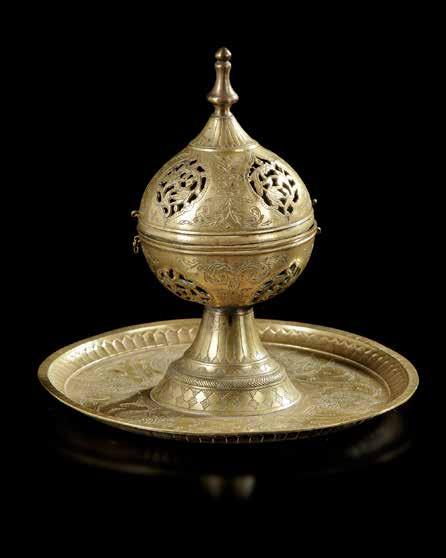
The body of truncated conical form with flanged base, perforated bands and everted drip-pan, the shaft with globed perforated bulb, the socket of spool form with ridges, engraved with a central band of cartouches containing incised inscriptions and thinner bands of chain pattern and foliate motifs. Height: 21.6 cm.
Inscription li-sahibihi al-sa’ada / wa al-salama / wa tu [l] / al’umr sahat (sic.) [ma nahat] hamama a / ‘To its owner Happiness and Well-being and Long-life as long as the dove coos’ This inscription can be found on Persian metalwork as early as the third quarter of the thirteenth century and continued to be engraved on later Persian and Ottoman works (see Melikian Chirvani 1982, p. 143).
PROVENANCE Private collection, Germany
Estimate € 12.000 - € 15.000
Lot 148
A BRASS INCENSE BURNER DECCAN, 16TH CENTURY

The ovoid body with a domed hinged cover surmounted by a baluster-form finial, decorated with palmettes containing an openwork foliate design separated by engraved floral motifs on a tall, gently splayed foot attached to a circular tray also engraved and punched with foliate palmettes and leafy vines.
Height: 18 cm. .
Diameter: 20 cm. max.
PROVENANCE Private collection, Germany
Estimate € 5000 - € 8000
Lot 150
AN OTTOMAN TOMBAK DOOR KNOCKER, OTTOMAN TURKEY 16TH CENTURY
An Ottoman tombak door knocker pierced with interlacing openwork of floral leafy sprays.
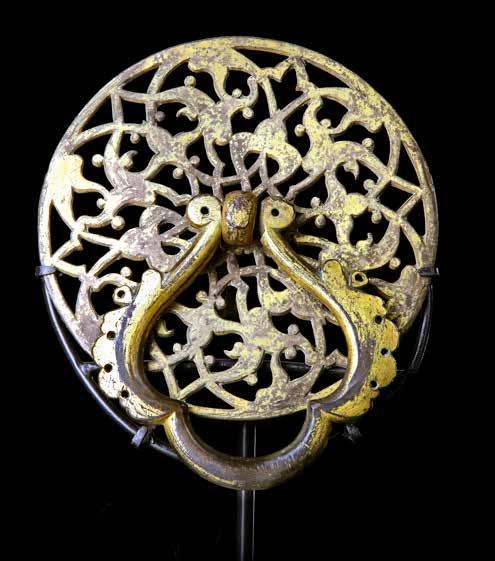
Diameter: 13 cm
Estimate € 3000 - € 5000
Lot 151
A SAFAVID STEEL OPENWORK PLAQUE PERSIA, 17TH CENTURY

of rectangular openwork form, the field divided into two zones: a central rectangular zone filled with inscription on a ground of scrolling flowers and split palmette leaves, framed by a rounded surround; and a border filled with inscription on a similar ground, the plain steel outer borders pierced with holes, the upper border with a frieze of trefoils 17.1 by 15.5 cm.
The inscriptions in the centre “Ya Hannan’ (Oh, the Most-Compassionate)”, in the borders part of Ayat Al-Kursi v.255 from surah Al-Baqraa
Estimate € 1500 - € 2000
A MONUMENTAL SAFAVID PIERCED-STEEL PROCESSIONAL STANDARD (‘ALAM), PERSIA 17TH CENTURY
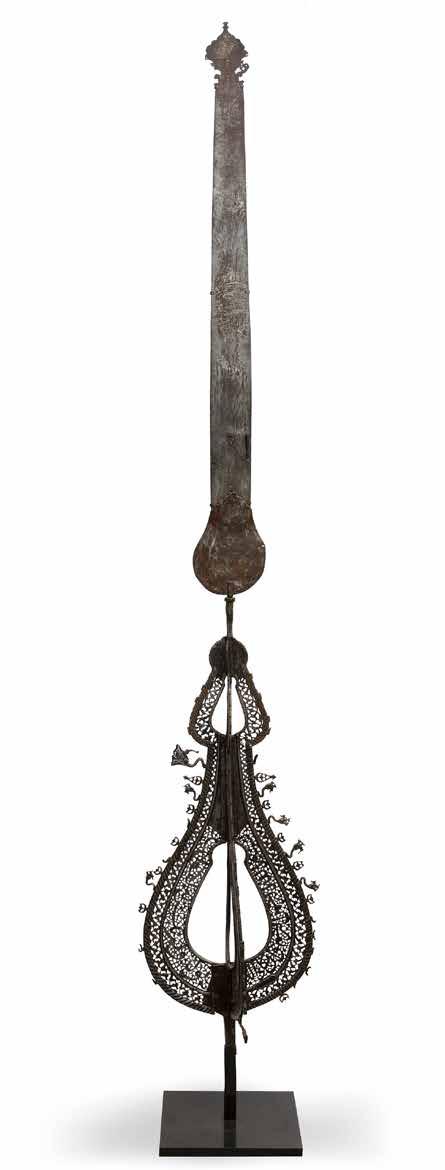
Comprising two drop-form sections fitted together with a quarter-lobed finial, featuring a tall fitted terminal above, the openwork design comprising elegant cursive calligraphy against a ground of foliated scrollwork bordered by a band of palmettes, within a ridged frame featuring stylized dragon-head terminals in between palmettes, mounted on customised metal stand.
Height: 265 cm.
Inscriptions surah Al-Ikhlas and v. 51 from surah Al-Qalam
Estimate € 30.000 - € 40.000
Lot 153
FIVE CUERDA SECA POTTERY TILES, PERSIA ZAND DYANSTY, 18TH CENTURY
Each of square form made of stone-paste, painted in yellow, turquoise, cobalt blue, black and opaque white with manganese purple in the cuerda seca (dry-cord) technique. Three tiles decorated with a figure of an archer seated on a horseback aiming at a deer in hunting scene amongst blossoming trees. Two tiles decorated with a seated youth drinking wine in a landscape. 20.5 by 20.5 cm.

Catalogue Note
Cuerda seca (Spanish for ‘dry cord’) developed as a technique alongside tile mosaics in the latter part of the fourteenth century in Central Asia and consisted of complete tiles painted with colored pigments which were separated from each other to prevent running by an oily substance mixed with manganese, which left a dark lining after firing.The technique continued to be utiles throughout Persia into the seventeenth and early into the eighteenth century.
Estimate € 4000 - € 6000
Lot 154
AN IMPORTANT KHURASAN SILVER INLAID BRONZE BOX

PERSIA 12TH-13TH CENTURY
A Khurasan twelve-sided box with lid applied with three hinged handles, decorated with silver-inlaid figures, zodiac signs, horsemen and animals within silver-inlaid interlacing geometrical frames. The lid decorated with a central geometrical designs surrounded by a band of Arabic inscriptions in Kufic script with traces of silver.
Height: 8 cm.
Diameter: 10 cm.
Estimate € 8000 - € 12.000
Lot 155
A KHURASAN BRASS EWER, PERSIA, EARLY 13TH CENTURY

On short splayed foot with a stylised kufic inscription and a lobbed drum-shaped body, each lob engraved decorated with two roundels enclosing floral leafy sprays and flanked by three bands of Kufic inscriptions, the shoulder decorated with a band of elegant thuluth inscriptions, the narrow neck on each side with a pronounced tiger boss and one further to the spout, a simple handle connecting the neck with the body.
Height: 37 cm.
Inscriptions perpetual glory, safe life, clear vision, approaching the best and best luck to its owner.
Lot 157
AN AYYUBID GILT BRONZE MAGIC BOWL, EGYPT OR SYRIA
13TH-14TH CENTURY
Of shallow rounded form engraved to the interior with talismanic diagrams and inscriptions, stars and images of a dog, snake, scorpion and two-headed dragon, the exterior with a band of inscriptions to the rim.
Diameter: 10.5 cm.
Inscriptions the outer band contains the names of various ailments that would be cured if drunk from this bowl, to the inner bowl quotes from the Quran, talismanic, magic texts and numbers.
PROVENANCE Private collection, Germany
Estimate € 3000 - € 5000
Lot 156
A FINE MUGHAL ENGRAVED BRASS TALISMANIC BOWL, INDIA

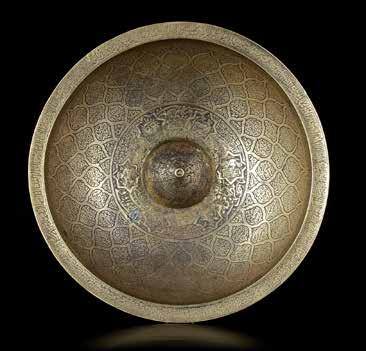
17TH CENTURY
Of rounded form with raised central boss and everted rim, finely incised and decorated with black lac, the interior with a band of roundels containing figures and a sun interspersed by inscription, surrounded by a band containing a repeat design of interlocking inscription-filled cartouches in nastaliq and thuluth, the border and rim with further inscriptions, the exterior with a series of cartouches containing the twelve signs of the zodiac, all on a ground of inscription, above and below bands of inscription, two bands of inscription-filled cartouches to foot.
Diameter: 22 cm.
Inscriptions including the Call to God to bless the Twelve Imams or the Fourteen Innocents and Quran, including alNasr and al-Saff.
Estimate € 2500 - € 3500
Lot 158
A SAFAVID SILK LAMPAS TEXTILE, SHAPED AS A SHIRT, 16TH CENTURY

The pattern depicts a courtier holding a wine jar pouring into a smaller bottle, a popular theme in Iranian decorative arts. The design features a seamless repeat pattern, elegantly alternating red, white and ochre yellow for the courtier’s cloak as well as the back ground, a design used by weavers to add variation. This pictorial composition is similar to manuscript paintings produced during the reign of Shah Tahmasp, and may be inspired by mystical poetry referencing wine and gardens. 84 by 56 cm.
Provenance
Private collection, Germany
Estimate € 6000 - € 8000
Lot 159
A MAGNIFICENT GERMAN IVORY TANKARD WITH PARCEL GILT MOUNTS DEPICTING AN OTTOMAN BATTLE, MADE FOR THE TURKISH MARKET
19TH CENTURY
The large and impressive tankard surmounted by a carved ivory figure of an Ottoman warrior holding a shield, on the domed brass, hinged cover decorated with pierced gilt scrolling Arabesques, the body of the tankard intricately carved with a battle scene from the Russo - Turkish war, with numerous figures on horseback and camels, the scrolling handle carved as the bust of a Russian soldier, raised on a domed base with pierced decoration, Height: 38 cm.
Estimate € 20.000 - € 30.000

Lot
TWO MUGHAL IVORY CASKETS, NORTHERN INDIA, 18TH CENTURY


Both of rectangular shape, each resting on bracket feet with gilt mounts, the low relief-carved decoration with dense repeat reticulated floral designs. The inside is divided into six compartments filled with small perfume bottles.
5.2 by 10.8 cm.
6.8 by 12.2 cm.
Lot 161
A KHOLMOGORY SCHOOL CARVED BONE BOX WITH MUGHAL INFLUENCE
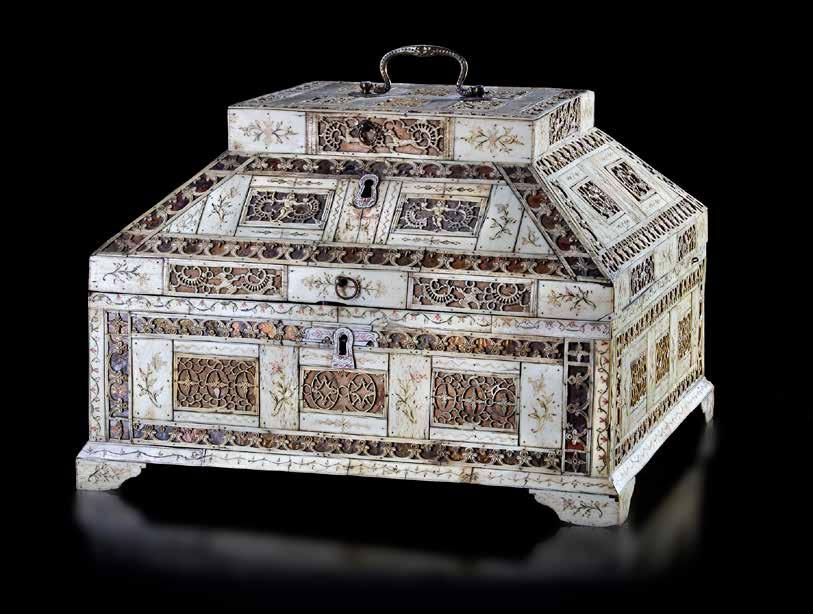
18TH CENTURY
The whole is richly carved with openwork plaques, which are heavily- inspired by Mughal decoration. The decorative plaques represent love, birds, dogs, squirrels and hunters, along with foliate-silhouetted rocks. The bottom part with interlaced quatrefoils; fleurs-de-lys, branches, foliage.
Kholmogory School, Arkhangelsk region
Height: 28.2 cm.
Length: 38 cm.
Estimate € 3000 - € 5000
Lot 162
A TIMURID CUERDA SECA POTTERY TILE, CENTRAL ASIA, 14TH-15TH CENTURY
Square, painted in green, yellow, red, turquoise and black outlines in reserve on a blue ground with a knotted Kufic inscription (al-mulk li-llah ‘Dominion is God’s’.)

Approx 28 by 27.5 cm.
PROVENANCE
Private collection, Germany
CATALOGUE NOTE
The Kufic inscription on this superb tile can be compared with the frontispiece from a manuscript copied for Bayjunghu ibn Shahruk in Herat around the year 1430 (Thomas W. Lents and Glenn D. Lowry, Timur and Princely Vision, Exhibition catalogue, Los Angeles County Museum of Art, 13th August - 5th November 1989, fig. 43.
Estimate € 8000 - € 12.000
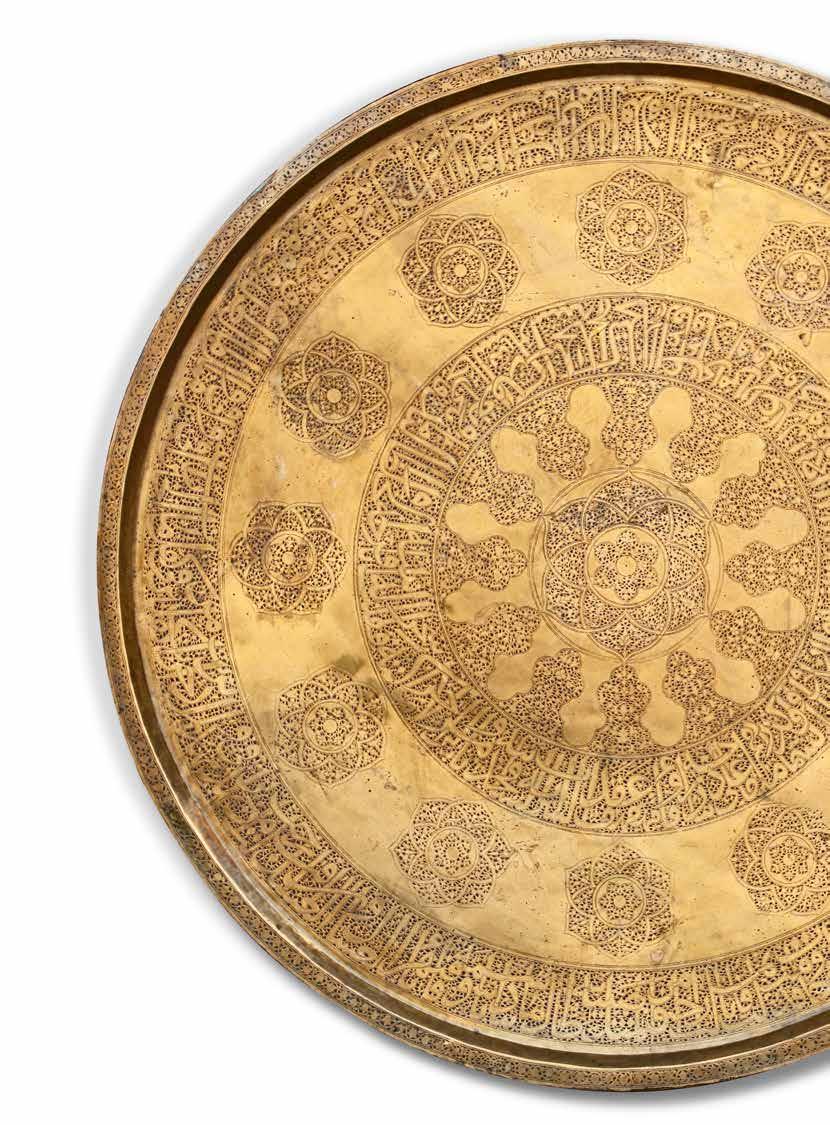
A LARGE OTTOMAN ENGRAVED BRASS TRAY, OTTOMAN SYRIA 16TH CENTURY
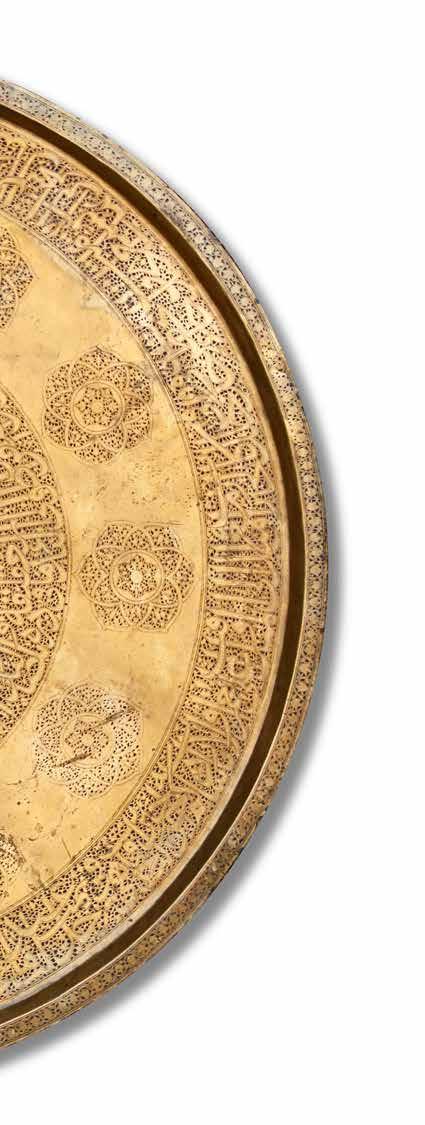
Of flat circular form with everted rim, the base with central radiating roundel containing strap-work rosette, further encircled by a broad band of bold thuluth followed by twelve ogival medallions containing arabesques and outer broad band in thuluth uninterrupted. The rim wit a simple plaited band.
Diameter: 112 cm.
Inscriptions in the tray
A poem from the famous poet Abu Al-Wafa Bin Omar Bin Abdul-Wahhab, the Shafi Mufti in Aleppo, 973 AH/1565 AD.
One of the most eminent scholars in knowledge, mastery, memorization and control in Aleppo in that time.
Estimate € 8000 - € 12.000
Lot 164
A SULTANATE COTTON TALISMANIC JAMA, MADE FOR AKBAR SHAH II INDIA, DATED 1255 AH/1810 AD
A shirt (jama) covered with text written in thuluth, naskh and ghubari scripts, in assorted colors, roundels and cartouches. The inscriptions include quotations from the Quran and the 99 Beautiful names of Allah. The cotton shirt inscribed with the entire text of the Quran written in black and red ghubari within a lattice of rectangles linked with red, blue roundels, surah headings written in naskh gold script outlined in black, each shoulder with a cluster of similar roundels with the words ya Allah, ya Hafiz and ya Fatih in gold, each rectangle with a single verse roundel in gold and polychrome at its centre, the lattice on either side interrupted by two large roundels containing kalifaat al-Tawhid in elongated gold bihari in mirrored style on a red and blue ground, each section of the lattice bordered with a wide band with the 99 names of Allah written in large thuluth gold script outlined in black in clouds reserved against a band of pink, red and blue dots on hatched ground. 103 by 72 cm.
This talismanic shirt was believed to be imbued with protective powers and may have been meant to be worn under armor in battle.
Estimate € 10.000- € 15.000
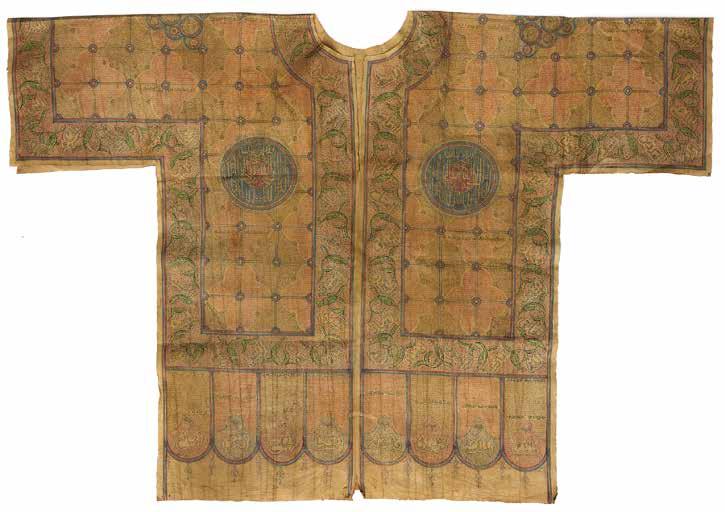
Lot 165
A RASULID LACQUER WOODEN BOX, YEMEN, 14TH CENTURY

With flat base and slightly sloping sides, the upper edge with slight recess to fit a lid, the exterior wooden surface overlaid in a succession of black, red, yellow and green and orange lacquers, then carved through to reveal a polychrome design, the broad central band with lobed roundels containing scrolling arabesques, the borders of the panels entwining and continuing into lobed concentric quatrefoils dividing each panel, a band below of stylized thuluth calligraphy interrupted by roundels containing quatrefoil panels.
Height: 31 cm.
Diameter: 26 cm.
Estimate € 5000- € 7000




